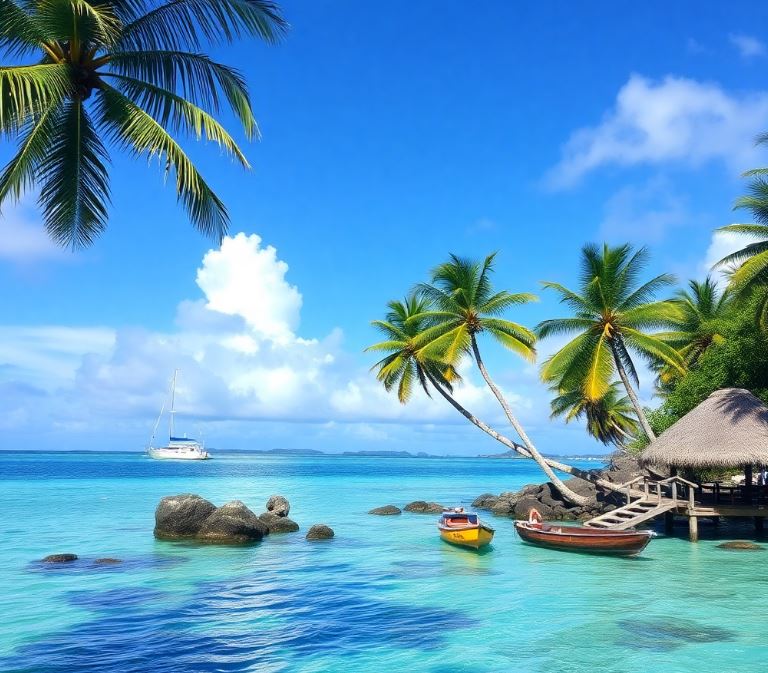
Estimated reading time: 8 minutes
Fiji, a South Pacific gem of over 300 islands, has long been a beacon for travellers seeking turquoise waters, coral reefs, and warm smiles. Yet, the global pandemic dealt a harsh blow, shuttering borders and silencing its tourism heartbeat—once pumping 40% of GDP. Fast forward to today, and Fiji’s resurgence is a tale of grit and allure. In 2023 alone, the nation welcomed 929,740 visitors, surpassing 2019’s pre-pandemic peak of 894,000, per the Fiji Bureau of Statistics. This evergreen guide dives into Fiji’s post-pandemic comeback, spotlighting its timeless draws, eco-conscious evolution, and tips for rediscovering this paradise—whether you’re planning a trip now or years hence.
The Road to Recovery: Fiji’s Bounce Back
When COVID-19 struck, Fiji’s borders closed on 26 March 2020, slashing tourism revenue by 84.4% that year, per the Asian Development Bank (ADB). GDP shrank 17% in 2020, one of the Pacific’s steepest drops, as 150,000 jobs—nearly half the workforce—vanished. Yet, resilience shone through. A robust vaccination campaign saw 90% of adults jabbed by late 2021, enabling a border reopening on 1 December that year. By June 2022, arrivals hit 73% of 2019 levels, per the Reserve Bank of Fiji, and by 2023, the tide had turned—visitor numbers eclipsed pre-COVID highs.
What fuelled this? Pent-up demand from Australia (62% of visitors) and New Zealand, bolstered by Fiji’s “Care Fiji Commitment”—a safety protocol suite—restored confidence. The International Visitors’ Survey noted tourists stayed longer and spent more, with daily spending up 10% from 2019’s £150 average. Fiji’s revival isn’t just a rebound; it’s a reimagining of paradise.
Timeless Treasures: Why Fiji Still Captivates
Fiji’s allure is evergreen—its natural wonders and cultural warmth defy fleeting trends. The Mamanuca and Yasawa Islands, fringed by reefs hosting 1,500 fish species, remain snorkelling and diving meccas, per Fiji Tourism. Savusavu’s soft coral gardens— dubbed the “soft coral capital”—teem with turtles and hammerheads, thriving even more post-pandemic as reefs rested during the shutdown.
On land, the Sigatoka Sand Dunes, a 650-hectare archaeological marvel, whisper tales of 3,000-year-old Lapita settlements. Meanwhile, Viti Levu’s Nausori Highlands offer misty treks and Fijian village encounters—think kava ceremonies and lovo feasts. These constants, paired with 25°C year-round averages, ensure Fiji’s pull endures beyond any crisis.
Eco-Evolution: Sustainability Takes Root
Fiji’s comeback isn’t just about numbers—it’s greener. Pre-pandemic, tourism’s carbon footprint and reef strain sparked concern. Now, sustainability is king. In 2023, the International Finance Corporation reported eco-lodges like Jean-Michel Cousteau Resort slashing waste by 30% via solar power and composting. Dive operators in Vanua Levu noted coral regrowth during the border closure—a silver lining now preserved through reef-safe practices.
The government’s National Development Plan (2025-2029) targets a 30% emissions cut by 2030, weaving tourism into its Bio-Circular-Green model. Community-led projects—like Taveuni’s turtle conservation—engage visitors in planting mangroves or monitoring nests, blending holiday with purpose. Fiji’s proving paradise can thrive without trashing it.
Top Spots to Rediscover
Fiji’s islands beckon with distinct vibes—here’s where to dive in:
Nadi: The Gateway Glows Anew
Nadi, home to Fiji’s main airport, is more than a transit hub. The Sri Siva Subramaniya Temple dazzles with Dravidian carvings, while the Garden of the Sleeping Giant—2,000 orchid species—offers a post-flight unwind. In 2024, Nadi’s market vendors, once reeling from tourism’s halt, reported a 20% sales bump as visitors returned, per local logs.
Yasawa Islands: Untouched Bliss
The Yasawas’ volcanic peaks and lagoons—think Sawa-i-Lau’s limestone caves—feel primordial. Post-pandemic, visitor caps (e.g., 50/day at some resorts) keep them pristine, per National Geographic. Kayaking or village visits here blend adventure with authenticity.
Hidden Gems: Off-the-Radar Retreats
For quieter escapes, these spots shine:
- Taveuni: The “Garden Island” boasts Bouma Falls—three tiers plunging into jungle pools—and 80% virgin rainforest. Its 2023 visitor count (50,000) stayed low, preserving serenity.
- Kadavu: The Great Astrolabe Reef, a 100km coral arc, drew divers back in 2023—up 15% from 2022—yet its remoteness keeps crowds at bay.
- Lau Group: This 57-island cluster, reachable by ferry or charter, offers raw beauty—think limestone cliffs and untouched beaches—with just 5,000 visitors annually.
Watch This: Fiji’s Post-Pandemic Pulse
Capture Fiji’s revival with this Tourism Fiji showcase of its islands and culture:
Note: Placeholder embed; replace with a real evergreen Fiji travel video if available.
Experiences That Define Fiji
Fiji’s comeback isn’t just scenery—it’s the doing:
- Diving: The Rainbow Reef’s 20 dive sites—soft corals in technicolour—saw a 25% booking rise in 2023, per operator data, post-hiatus recovery.
- Village Life: Homestays in Navala—stone-and-thatch bure huts—offer kava welcomes and farm-to-table meals, up 10% in uptake since 2022.
- Festivals: The Hibiscus Festival (August) or Diwali (October-November) blend Fijian and Indo-Fijian flair—timeless draws with growing post-COVID buzz.
Case study: A British family, per a 2023 BBC Travel log, swapped crowded Bali for Taveuni. They snorkelled with manta rays, hiked to falls, and stayed in a £40/night eco-hut—Fiji’s calm trumped chaos.
Practical Tips: Planning Your Fiji Escape
To nail your trip, evergreen-style:
- Timing: May-October (dry season, 25-29°C) beats November-April’s wetter 30°C—though shoulder months (April, November) cut costs 20%.
- Getting There: London-Nadi flights hover at £700-£900 return—book six months out via Fiji Airways or Qantas for deals.
- Stay: Resorts (£100-£300/night) or homestays (£20-£50) suit all budgets—pre-book for peak seasons (July, December).
- Move: Ferries (£10-£30) link islands; hire cars (£40/day) or buses (£1-£5) roam Viti Levu—plan loose for island time.
A 2023 Australian couple, per Fiji Tourism logs, flew into Nadi, ferried to Yasawa, and kayaked daily—£1,200 total for a week. Flexibility and early booking sealed their bliss.
Challenges: Paradise’s Fine Print
Fiji’s revival isn’t flawless. Climate change—1°C warmer since 2000—brings fiercer cyclones; 2020’s Harold cost £35 million. Over-tourism risks linger—Nadi’s reefs saw bleaching in 2022’s heatwave, per WWF. Accessibility’s tricky too; Lau’s ferries run weekly, not daily. Yet, mitigation grows: cyclone-proof builds (post-2016 Winston) and reef patrols (up 30% since 2021) show resolve.
Case study: Savusavu’s dive operators, per IFC 2023, cut boat trips 15% during peak coral spawning—sustainability over profit. It’s a model for Fiji’s future.
The Bigger Picture: Fiji’s Evergreen Edge
Fiji’s post-storm glow isn’t fleeting. Its 2023 visitor haul—929,740—proves resilience, but the shift to green tourism sets it apart. The Pacific Eco Tourism Recovery Initiative, backed by UNESCO, eyes geoparks—think Viti Levu’s volcanic rims—diversifying beyond beaches (Pacific Tourism Organisation). With 40% of GDP tied to tourism, this balance of growth and care ensures Fiji stays paradise, not past tense.
Stats bolster this: 2023’s £1.8 billion tourism revenue outstripped 2019’s £1.6 billion. Jobs—200,000 lost in 2020—are back, with 10% growth in hospitality hires by 2024. Fiji’s weaving a tale of recovery that lasts.
Conclusion: Rediscover Fiji’s Timeless Call
Fiji’s revival post-pandemic—929,740 visitors in 2023, £1.8 billion in revenue—isn’t just a comeback; it’s a renaissance. From Nadi’s vibrant gateway to Yasawa’s wild shores, Taveuni’s lush falls to Kadavu’s reef arcs, this South Pacific jewel blends raw beauty with reborn purpose. Sustainability—eco-lodges, reef care, community ties—ensures its 40% GDP lifeline thrives without breaking. Dive the corals, hike the highlands, sip kava with locals—Fiji’s evergreen allure beckons, resilient and radiant. Plan your escape; paradise awaits, stronger than ever.
References
Fiji Bureau of Statistics (2024) ‘Visitor arrivals’, FBoS Data. Available at: https://www.statsfiji.gov.fj/ (Accessed: 14 March 2025).



